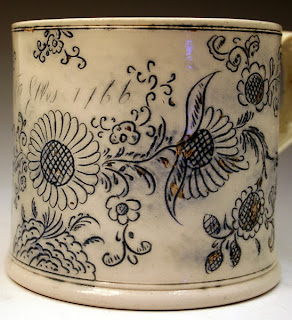From c. 1740, English stoneware underwent a vigorous phase of development in response to competition from Chinese porcelain, the Staffordshire potters leading the way in evolving a whiter body for inexpensive utility wares such as bottles, jars and preserve pots.
the basic improvement was to add white Devonshire clay and powdered flint to the ingredients. These additions, combined with a new method of slip cast moulding, allowed the production of a lightweight, durable, white body capable of being cast in delicate, detailed shapes, and of withstanding the impact of boiling water. As with brown saltglaze, a pitted "orange peel" surface is characteristic.
These wares were often put to daily use. Moreover, cast saltglaze, unlike delft or porcelain, tends to shatter rather than crack when knocked hard. Hence, although made in the large numbers, these items are scarce and collectable today.
Products included loving cups, mugs, plates, jugs in the forms of owls, and teapots in whimsical shapes - camels, houses and so on. Typically, stamped reliefs decorate early wares. Sgraffito decoration was also used , the incision being filled in with blue pigment - a technique known as "scratch-blue". Some pieces were left undecorated.
Enamel colours became popular after c. 1745, reproducing the fashionable famille rose and famille verte palettes of Chinese porcelain. The colours on enamelled saltglaze stand out bright and clear.
White saltglaze is an increasingly popular collecting area. Moulded wares and figure groups now fetch high prices.
the basic improvement was to add white Devonshire clay and powdered flint to the ingredients. These additions, combined with a new method of slip cast moulding, allowed the production of a lightweight, durable, white body capable of being cast in delicate, detailed shapes, and of withstanding the impact of boiling water. As with brown saltglaze, a pitted "orange peel" surface is characteristic.
These wares were often put to daily use. Moreover, cast saltglaze, unlike delft or porcelain, tends to shatter rather than crack when knocked hard. Hence, although made in the large numbers, these items are scarce and collectable today.
Products included loving cups, mugs, plates, jugs in the forms of owls, and teapots in whimsical shapes - camels, houses and so on. Typically, stamped reliefs decorate early wares. Sgraffito decoration was also used , the incision being filled in with blue pigment - a technique known as "scratch-blue". Some pieces were left undecorated.
Enamel colours became popular after c. 1745, reproducing the fashionable famille rose and famille verte palettes of Chinese porcelain. The colours on enamelled saltglaze stand out bright and clear.
White saltglaze is an increasingly popular collecting area. Moulded wares and figure groups now fetch high prices.






No comments:
Post a Comment